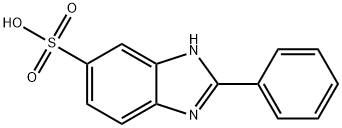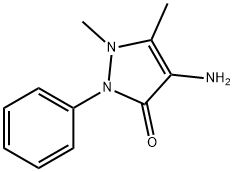2-(4-Aminophenyl)-1H-benzimidazol-5-amine
- CAS NO.:7621-86-5
- Empirical Formula: C13H12N4
- Molecular Weight: 224.26
- MDL number: MFCD00451475
- EINECS: 231-538-6
- SAFETY DATA SHEET (SDS)
- Update Date: 2024-08-19 17:35:41

What is 2-(4-Aminophenyl)-1H-benzimidazol-5-amine?
Description
2-(4-Aminophenyl)-1H-benzimidazol-5-amine (APBIA) is a synthetic raw material for the preparation of sulfonated polyimides containing benzimidazole (SPIBIs). The synthesised SPIBIs with polyhedral oligomeric silsesquioxane glycidyl ethers (G-POSS) can be used to prepare a number of novel organic-inorganic hybrid proton exchange membranes (PEMs). The obtained membranes exhibited good crosslink density at all gel fractions above 75%. The mechanical properties, oxidative stability and hydrolytic stability of the crosslinked membranes were significantly improved compared with those of pure SPIBI membranes.
The Uses of 2-(4-Aminophenyl)-1H-benzimidazol-5-amine
2-(4-Aminophenyl)-1H-benzimidazol-5-amine is a useful as an aerogel lithium battery separator.
Safety Profile
Low toxicity by ingestion. Whenheated to decomposition it emits toxic vapors of NOx.
Properties of 2-(4-Aminophenyl)-1H-benzimidazol-5-amine
| Melting point: | 234.0 to 238.0 °C |
| Boiling point: | 355.66°C (rough estimate) |
| Density | 1.2067 (rough estimate) |
| refractive index | 1.5890 (estimate) |
| storage temp. | Keep in dark place,Inert atmosphere,Room temperature |
| solubility | DMSO (Slightly), Methanol (Slightly) |
| form | Solid |
| pka | 11.15±0.10(Predicted) |
| color | Pale Beige to Pale Brown |
| λmax | 335nm(EtOH)(lit.) |
| InChI | InChI=1S/C13H12N4/c14-9-3-1-8(2-4-9)13-16-11-6-5-10(15)7-12(11)17-13/h1-7H,14-15H2,(H,16,17) |
| EPA Substance Registry System | 1H-Benzimidazol-5-amine, 2-(4-aminophenyl)- (7621-86-5) |
Safety information for 2-(4-Aminophenyl)-1H-benzimidazol-5-amine
| Signal word | Warning |
| Pictogram(s) |
 Exclamation Mark Irritant GHS07  Health Hazard GHS08 |
| GHS Hazard Statements |
H315:Skin corrosion/irritation H319:Serious eye damage/eye irritation H335:Specific target organ toxicity, single exposure;Respiratory tract irritation H341:Germ cell mutagenicity |
| Precautionary Statement Codes |
P280:Wear protective gloves/protective clothing/eye protection/face protection. P302+P352:IF ON SKIN: wash with plenty of soap and water. P305+P351+P338:IF IN EYES: Rinse cautiously with water for several minutes. Remove contact lenses, if present and easy to do. Continuerinsing. |
Computed Descriptors for 2-(4-Aminophenyl)-1H-benzimidazol-5-amine
| InChIKey | XAFOTXWPFVZQAZ-UHFFFAOYSA-N |
| SMILES | C1(C2=CC=C(N)C=C2)NC2=CC(N)=CC=C2N=1 |
New Products
4-AMINO-TETRAHYDRO-PYRAN-4-CARBOXYLIC ACID HCL 4-(Dimethylamino)tetrahydro-2H-pyran-4-carbonitrile 4-Aminotetrahydropyran-4-carbonitrile Hydrochloride (R)-3-Aminobutanenitrile Hydrochloride 3-((Dimethylamino)methyl)-5-methylhexan-2-one oxalate 1,4-Dioxa-8-azaspiro[4.5]decane 5-Bromo-2-nitropyridine Nimesulide BP Aceclofenac IP/BP/EP Diclofenac Sodium IP/BP/EP/USP Mefenamic Acid IP/BP/EP/USP Ornidazole IP Diclofenac Potassium THOMAIND PAPER PH 2.0 TO 4.5 1 BOX BUFFER CAPSULE PH 9.2 - 10 CAP SODIUM CHLORIDE 0.1N CVS ALLOXAN MONOHYDRATE 98% PLATINUM 0.5% ON 3 MM ALUMINA PELLETS (TYPE 73) LITHIUM AAS SOLUTION 2-Bromo-1-(bromomethyl)-3-chloro-5-nitrobenzene 2-Bromo-3-nitroaniline N-(3-Hydroxypropyl)-N-methylacetamide 3-Bromo-6-chloropyridazine 4-ethyl-3-nitrobenzoic acidRelated products of tetrahydrofuran








You may like
-
 5-Amino-2-(4-aminophenyl)benzimidazole CAS 7621-86-5View Details
5-Amino-2-(4-aminophenyl)benzimidazole CAS 7621-86-5View Details
7621-86-5 -
 1-Methyl-6-oxo-1,6-dihydropyridazine-3-carbonitrile 98%View Details
1-Methyl-6-oxo-1,6-dihydropyridazine-3-carbonitrile 98%View Details
99903-60-3 -
 1823368-42-8 98%View Details
1823368-42-8 98%View Details
1823368-42-8 -
 2-(3-(tert-butyl)phenoxy)-2-methylpropanoic acid 1307449-08-6 98%View Details
2-(3-(tert-butyl)phenoxy)-2-methylpropanoic acid 1307449-08-6 98%View Details
1307449-08-6 -
 Ethyl 3-(furan-2-yl)-3-hydroxypropanoate 25408-95-1 98%View Details
Ethyl 3-(furan-2-yl)-3-hydroxypropanoate 25408-95-1 98%View Details
25408-95-1 -
 2-Chloro-5-fluoro-1-methoxy-3-methylbenzene 98%View Details
2-Chloro-5-fluoro-1-methoxy-3-methylbenzene 98%View Details
1805639-70-6 -
 1784294-80-9 98%View Details
1784294-80-9 98%View Details
1784294-80-9 -
 Lithium ClavulanateView Details
Lithium ClavulanateView Details
61177-44-4